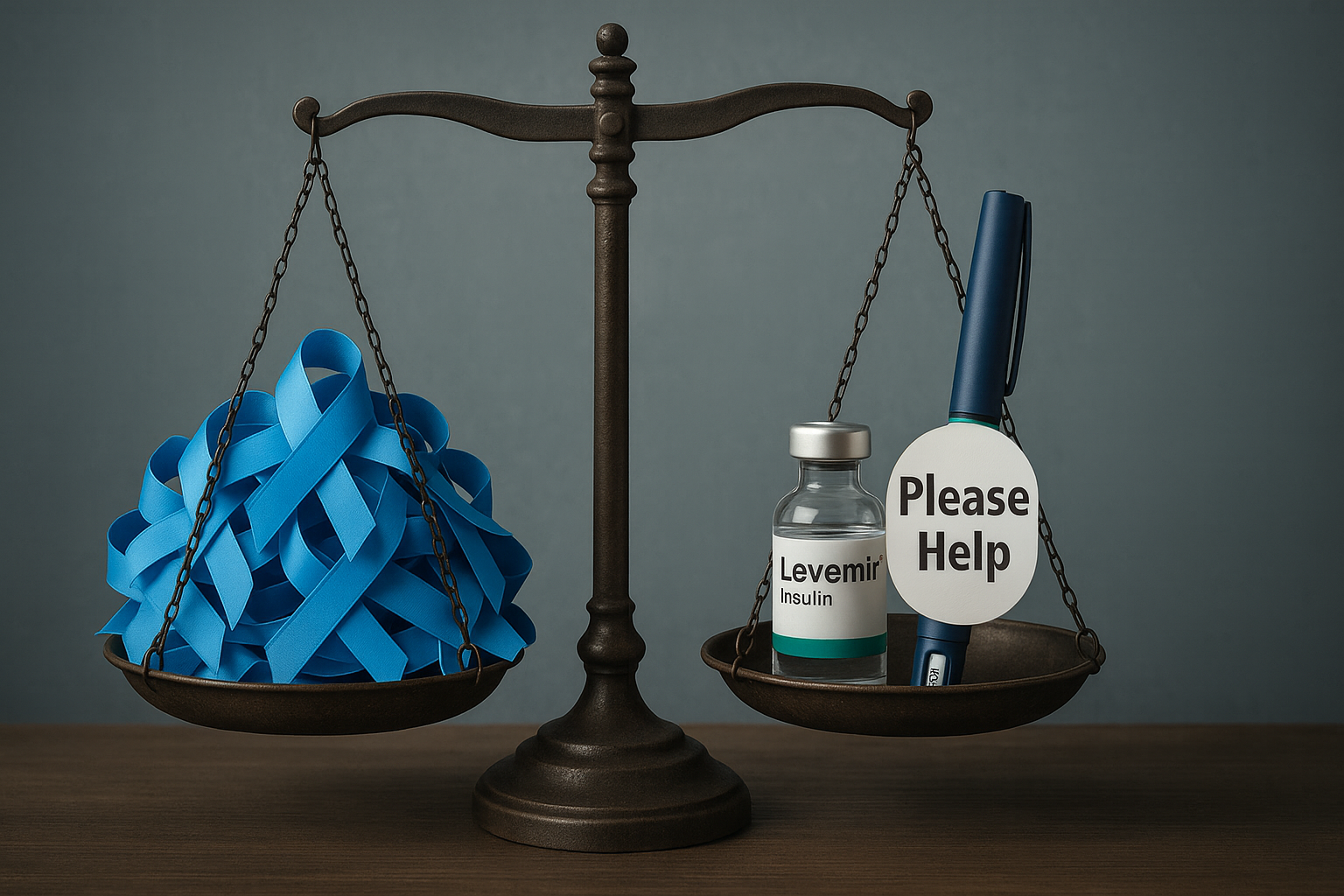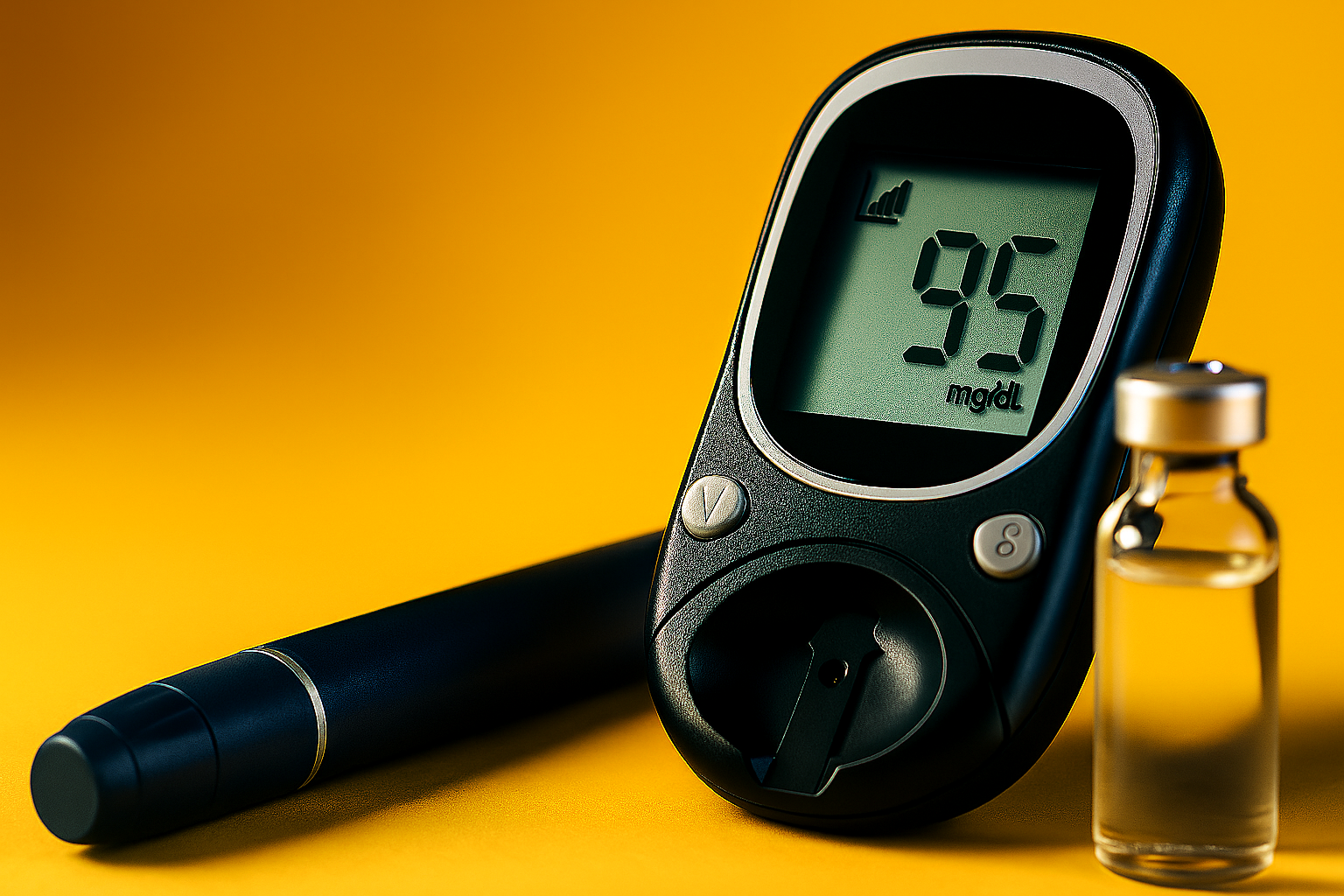New test better predicts which babies will develop type 1 diabetes
from Science Daily, August 7, 2020 - University of Exeter
Scientists at seven international sites have followed 7,798 children at high risk of developing type 1 diabetes from birth, over nine years, in The Environmental Determinants of Diabetes in the Young (TEDDY) Study. The TEDDY Study is a large international study funded primarily by the US National Institutes of Health and U.S. Centers for Disease Control, as well as by the charity JDRF.
In research published in Nature Medicine, scientists at the University of Exeter and the Pacific Northwest Research Institute in Seattle used the TEDDY data to develop a method of combining multiple factors that could influence whether a child is likely to develop type 1 diabetes. The combined risk score approach incorporates genetics, clinical factors such as family history of diabetes, and their count of islet autoantibodies -- biomarkers known to be implicated in type 1 diabetes.
The research team found that the new combined approach dramatically improved prediction of which children would develop type 1 diabetes, potentially allowing better diabetes risk counselling of families. Most importantly, the new approach doubled the efficiency of programmes to screen newborns to prevent the potentially deadly condition of ketoacidosis, a consequence of type 1 diabetes in which insulin deficiency causes the blood to become too acidic. Identifying which children are at highest risk will also benefit clinical trials on drugs that are showing promise in preventing the condition.
Dr Lauric Ferrat at the University of Exeter Medical School, said: "At the moment, 40 per cent of children who are diagnosed with type 1 diabetes have the severe complication of ketoacidosis. For the very young this is life-threatening, resulting in long intensive hospitalizations and in some cases even paralysis or death. Using our new combined approach to identify which babies will develop diabetes can prevent these tragedies, and ensure children are on the right treatment pathway earlier in life, meaning better health."
Professor William Hagopian of the Pacific Northwest Research Institute, said: "We're really excited by these findings. They suggest that the routine heel prick testing of babies done at birth, could go a long way towards preventing early sickness as well as predicting which children will get type 1 diabetes years later. We're now putting this to the test in a trial in Washington State. We hope it will ultimately be used internationally to identify the condition as early as possible, and to power efforts to prevent the disease."
Researchers believe the combined approach can also be rolled out to predict the onset of other diseases with a strong genetic component that are identifiable in childhood, such as celiac disease.
Sanjoy Dutta, JDRF Vice President of Research, said:" We know that while genetics have a strong correlation as a risk factor for family members to develop T1D, most newly diagnosed individuals do not have a known family history. JDRF has been exploring the non-genetic, environmental risk factors that trigger T1D to help develop treatments to forestall or prevent disease onset."
Complete info is available at Science Daily
An Average Day with Type 1 Diabetes
Most days are perfectly imperfect…
If you already listen to the Juicebox Podcast this quick post will serve as a reminder that:
There is a way to eat normally and achieve the A1c that you want.
A great A1c doesn’t necessarily mean that your BG is 85 (4.7) all day and night long.
Just because you haven’t figured something out doesn't mean that an answer doesn’t exist.
If you haven’t yet listened, I hope that this post represents what is possible when you:
Have easy to understand tools for using insulin.
Listen to the Juicebox Podcast at JuiceboxPodcast.com, Apple Podcasts, Spotify or on your favorite podcast app..
Try these episode to start #11 Bold With insulin, #29 Fear of insulin, #37, Jenny Smith, #44 Diabetes Rollercoaster, #62 Unfounded Fear, #100 Revisiting Bold, #105 All About A1c, #121 Insulin, Insulin, Insulin
You can always listen to the Juicebox Podcast or your favorite podcast app but if you don’t have one try one of these. Apple Podcasts/iOS - Spotify - Amazon Alexa - google play/android - iheart radio - .
Getting to Bold
In the beginning of our life with type 1 diabetes I would cry in the shower...
The shower seemed like a good place to vent my fear, frustration and utter lack of confidence. I would emerge reborn having dumped my anxiety down the drain. The guilt and pressure would of course build up again but the venting would usually hold me over for a week or so. During that time I believed that this was how my life would always be. Every time Arden's blood sugar was too high, too low or just plain all over the place, I would think...
"Well, that's just diabetes. There is nothing I can do, it's out of my hands."
Here's the secret though. That's not just diabetes. At least it doesn't have to be.
This blog and the people reading it saved me from that life but not perhaps in the way you might imagine. If you were to go back a decade and read my posts you would see a person struggling as I've described here. The blog was a raw nerve, a mirror to my worst moments, periodic triumphs and ardent fears. I would have an experience and then write about it. It was cathartic for me and the readers felt supported because they saw their lives in mine. This was my original concept of what a blog was for and what community meant. I would share my life transparently and you got the relief that came with knowing that you weren't alone. My daughter's A1c was 9, yours sucked too and we all felt the momentary relief of sameness.
My idea of community has grown
I would make incremental yet unsatisfying improvements to Arden's care. We got an Omnipod insulin pump and her A1c went down, we cut out some foods and it went down again. Still, no great shakes just lower. Eventually Arden got a Dexcom CGM but all that seemed to do was enforce the notion that I sucked at taking care of my daughter's disease. Then one day our nurse practitioner told me that the biggest hurdle in type 1 diabetes management was fear.
More specifically. The fear of insulin
Those words clicked in my head and I began to force myself to not be afraid. This was no small feat as you are reading the thoughts of a person who caused two seizures in their daughter. Twice in the beginning years with type 1 diabetes I gave Arden too much insulin and she had a seizure. Today I realize that it wasn't the insulin that caused the seizures, at least not completely. It was my ignorance about how the insulin worked. When I realized that... everything began to change.
Bold T-shirts
Arden's A1c went from 9 to 8.5 to 8 to 7.5 to 7 to 6 to 5.6
“A platitude is a statement that has been repeated so often that it is meaningless. ”
I figured it out. The next question was what is "it" and more importantly how do I share it with you without the platitudes that often strangle our community. Have you ever heard that, "marriage takes work" or been told to "enjoy this... it goes by so fast"? People love to say stuff but then not give you any details. Have you ever wondered why we don't speak with more detail? I think that some stuff doesn't require more so we don't offer more. We also often don't have the luxury of the time it takes to fully explain. Diabetes however deserves and requires the next level of the thought to be shared, for time to be taken. The tried and true methods should be given to anyone who is interested in knowing them. The problem is that it would be a lifetime of blog posts or a library full of books that you could never read. Still, what if you read the answer but couldn't apply the information or didn't quite understand and needed one more example. We say crap like, "well, that's just diabetes" because it's difficult to do more and those platitudes rob us of hope. One day I got tired of accepting that and wanted to do more. I threw out the old chestnut that tells us that everyones diabetes is different and that experiences can't be thoughtfully applied to others. I ignored that trope because it is not completely true and I knew that I could find a way to extract the basic tenants of diabetes and apply them to everyone. Once I did that the next step was to give the ideas the weight that they deserved and the thoughtful explanation that they required. Above all else, I wanted to provide real tools that were easy to use for the people who were ready to try and hope that one day they would be ready to those who weren't quite there yet.
A Phone call
Recent Juicebox Podcast reviews. Click to expand. Seriously, read them.
When you share online people sometimes contact you to ask questions. As you can tell by this post I can get wordy when I write. So one day when I received a question from one of you and I responded, "maybe just call me". The first time that I spent a half hour on the phone with a stranger explaining the tenants that I use in the day-to-day management of diabetes... it felt weird. That strange feeling was replaced a few days later when that person contacted me again to say that they understood. They made the changes that we spoke about and their child's blood sugars were suddenly and markedly better. I asked that person to keep in touch. I say that to everyone today. "Keep in touch... let me know how this worked out". I say it to everyone for two reasons. 1. I really do care and 2. your feedback helps me the next time that I speak to someone. When that first person reached back out six months later with a significantly reduced A1c I thought, "I wish I could talk to everybody at the same time.".
So I started the Juicebox Podcast
The episodes of the podcast are self-contained, organic conversations that will help you to get to a better place with diabetes. But that isn't the real benefit of the podcast. Those episodes when combined reflect my continued maturation as a person living with diabetes. They are powerful separately but together they are an organic conversation that grows and builds and teaches - both me and the people listening. I never would have believed that it would be so powerful but I see it today in your social media posts, reviews and personal letters.
Here's what I know. When I am Bold With Insulin my daughter's life is better. She is healthier, happier and less burdened by diabetes. I then take what I've experienced and we talk about it on the podcast. You will absorb information and begin to apply ideas in no time. I've tried to replace those hope draining platitudes with simple ideas supported by easy to understand details about how to make them work. I'm not a doctor but I do have a decade of crowd- sourced experiences and a knack for explaining them.
You can help to shape how people talk and live
There are three people reading this post. Those of you who are already being bold, those who want to be and those who aren't sure if you can. If you you're already there, please help to keep the platitudes out of the diabetes conversation. Be supportive without being reductive and encourage people to be bold. If you know the there is more to diabetes than what you've been told. If you can feel it in your gut but can't quite bring it into reality. Please listen to the podcast. If you think that I'm full of crap or just can't imagine things being better. Please, take a leap of faith. A better life is waiting on the other side.
Be Bold With Insulin - Listen to the Juicebox Podcast
On your iPhone or Apple Podcasts
On your Android phone or Google Play
You can also listen on your favorite podcast app by searching for Juicebox Podcast. The podcast is completely free for all listeners.
Flu Season Tips
updated 2/25/20
Flu season has arrived and the sad fact is that no matter how hard you try, sometimes you just can't avoid getting the flu. Dr. Adam Naddelman, MD, FAAP, President, Princeton Nassau Pediatrics, P.A. has a few tips on how to elude the flu, spot the virus in it's early stages, and what to do when you think that you've been bitten by the bug.
Preventative measures (from flu.gov)
Avoid close contact with people who are sick. When you are sick, keep your distance from others.
Stay home when you are sick. If possible, stay home from work, school, and errands when you are sick. This will help prevent spreading your illness to others.
Cover your mouth and nose with a tissue when coughing or sneezing. Flu and other serious respiratory illnesses, like respiratory syncytial virus (RSV), whooping cough, and severe acute respiratory syndrome (SARS), are spread by cough, sneezing, or unclean hands.
Clean your hands. Washing your hands often will help protect you from germs. If soap and water are not available, use an alcohol-based hand rub.
Avoid touching your eyes, nose or mouth. Germs are often spread when a person touches something that is contaminated with germs and then touches his or her eyes, nose, or mouth.
Practice other good health habits.Clean and disinfect frequently touched surfaces at home, work or school, especially when someone is ill. Get plenty of sleep, be physically active, manage your stress, drink plenty of fluids, and eat nutritious food.
Early flu signs
Fever, usually 102º - 104º
Cough
Body aches that can be severe
Once symptoms begin
People who are high risk (chronic illness like diabetes and asthma, elderly or kids under 2) should seek medical care quickly. If the flu is diagnosed within the first 48 hours, antiviral drugs can be prescribed in hopes of shortening and/or lessening the effects of the flu. A full list of who is considered to be high risk can be found at Flu.gov.
For those considered low risk, Dr. Naddelman believes the best treatment is supportive care, including plenty of fluids, antipyretics to reduce fever and body aches, and lots of rest.
Considering emergency medical assistance? Listen to episode 307 of the Juicebox Podcast
Dr. Naddelman stresses the importance of being on the look out for secondary infections with the flu, particularly pneumonia. Signs of influenza leading to a secondary bacterial infection like pneumonia include a high spiking fever several days into the illness, increasing cough and lethargy, and decreased appetite and oral intake. These signs require immediate medical attention.
Once you've kicked the flu waiting twenty-four hours to reintroduce yourself to the public after your symptoms and fever have resolved is considered best practice.
Dr. Naddelman practices pediatrics, but his advice is transferrable to patients of all ages.
This is a very good time for me to remind you that I am not a doctor and that nothing I write on Arden's Day or anywhere else should be taken as medical advice. My disclaimer says it all but you should really contact your own physician whenever you have questions about your or a loved ones health. Especially when the flu is involved.
You Too Can Bolus for Chinese Take Out
A successful insulin bolus is all about the balance between amount and timing.
Arden recently had Chinese takeout that consisted of sesame chicken, white rice and edamame.
Take a look at her 24 hour Dexcom graph and see if you can guess what time Arden ate the Chinese food. The yellow block represents a restart of her Dexcom CGM.
Now lets talk about the insulin that we used for the meal. Try not to look at the next graph yet...
History tells me that Arden will need between 9 and 10 units of insulin for this food. I don't know how much she'll eat and I don't know how many carbs the food contains. Honestly, I don't care about the carb count for two reasons. 1. I know historically how much insulin this food requires, the trick is to time it correctly. 2. Even if I use the correct amount of insulin the bolus won't work if it's mis-timed.
Example of Correct Amount of Insulin not leading to desired result
Bolusing the entire amount too soon will cause a crash while eating because the carbs will get overpowered by the insulin. Correcting this low will lead to a crazy high later (unless you add insulin, which you'll likely be afraid to do because of the initial low. However, that would likely be the correct thing to do). Outcome: UNDESIRED
Bolusing the entire amount too late will cause a spike that won't come down because the carbs will overpower the insulin, rocketing the BG. This result now voids the "correct" amount of insulin. Yes you used the correct amount of insulin for the food initially but the unintended spike has not been compensated for by insulin. Mis-timing the insulin created another insulin requirement. This spike will last forever without more insulin. Outcome: UNDESIRED
Take away: The insulin, even in the correct proportion, will inevitably not be successful if it is mis-timed.
What does timing mean in simple terms?
The fight between carbs and insulin needs to be balanced. Imagine a tug of war. If one side pulls first, the flag in the middle of the rope becomes uncentered. Now the side that pulled first has a huge advantage that the other side probably can't overcome. When we bolus we want the insulin and the carbs to pull at the same time so that the flag stays right in the middle.
The first step to a balanced pre bolus is understanding the insulin. Man-made insulin does not work immediately and you need to figure out how long it takes to work for you. It may be five, ten, fifteen or more minutes, figure it out. None of this will work without pre bolusing. Trust that.
Once you know how long it takes for your insulin to begin to reduce your BG, consider the food. Something sugary will hit your BG quicker while a heavier less volatile carb like bread may take longer to start pulling up your BG but then last much longer in your system. Each food type will need different timing considerations and hence a different pre bolus.
None of this needs to be perfect because you can always readdress as you go (made easier with the Dexcom CGM and an insulin pump but not undoable with injections).
Understand the roll of basal insulin. Pumpers have a basal rate set that is trying to hold a steady BG during the day. When carbs are added and your insulin needs increase, you aren't just stuck with one weapon (bolus) you can also blanket the carb richer hours with more basal insulin. (Extra basal also does wonders bringing down a spike or stubborn high BG). So don't just use a targeted strike (bolus), carpet bomb too with an increased basal rate. Decreased basal rates are also effective in handling stubborn lows without carbs.
Okay lets take a breath because none of this is nearly as complicated as it seems. Lets go over some basic tenets and then look at the Chinese food graph.
You have to pre-bolus to create a balanced fight between carbs and insulin.
Temporary basal rate increases and decreases are a vital tool.
If your BG is too high. You didn't use enough insulin, you mis-timed it or a combination of both.
If your BG is too low. You used too much insulin, you mis-timed it or a combination of both.
When your BG gets high do not spend time trying to figure out why, just get it down. Figure it out later.
When something goes wrong, its not a mistake to beat yourself up over. It is actionable data, a learning experience that will help you make a better decision next time.
CGM users: Stop the arrow without causing another one. Bump and nudge the graph line. Small adjustments will keep you off the diabetes rollercoaster.
It is far easier to stop a low or falling BG then it is to effect a high and stubborn BG.
Often you get what you expect so expect BGs in the 70 - 110 range and make them your goal. CGM users: Set thresholds that allow you to react before it is too late.
Be bold with insulin.
It's time to look at the graph from the Chinese food. Do you remember when you thought Arden ate? Did you guess around 3 pm? Actually, the spike at 3 pm was one tiny snack with a mis-timed pre-bolus. The take-out was at 7 pm. Check it out.
Simply put. I cranked up Arden's basal about 20 minutes before the food arrived and bolused 3.00. Thats 4.00 units in, 6.00 more needed. The next 1.50 went in when the food began to create space between pre-bolus. I need to stretch the insulin impact because there are two different carbs at work in this example. The sugar on the chicken is going to act fast so the pre-bolus and temp basal needed a head start. The next issue is the white rice which brings a heavy impact that is also long-lasting so we need force and staying power. I held the balance of the insulin until the rice started to make its impact around 7:40 pm. I should have bolused the remaining 3.80 all at once but I played it a bit safe because I knew that we were about to lose the Dexcom data for two hours. Had I sent the entire 3.80 at 7:40 the BG wouldn't have made it to 140. Thats it. We tested half way through the Dexcom restart to be safe and to make sure that Arden didn't need more insulin.
You may be inclined to say that this is too much effort but I contend that the few moments that it took to make these adjustments is a far better world to live in then spending the next five hours bolusing a high number that just won't move. It will take you a few tries to make sense of everything but one day you'll have it and all of this will feel easy. Arden eats what she wants and her A1c has been between 5.6 and 6.2 for four years. Be bold with insulin!
You many also like:
Blog post: Anatomy of a High Carb Breakfast
Podcast: Bold With Insulin
If you want to continue to find out more about how we manage type 1 diabetes please check out my podcast. The Juicebox Podcast is free and available on all podcast apps and online. Subscribe and start listening today!
I am not a doctor and this is not advice. Disclaimer is here.















































